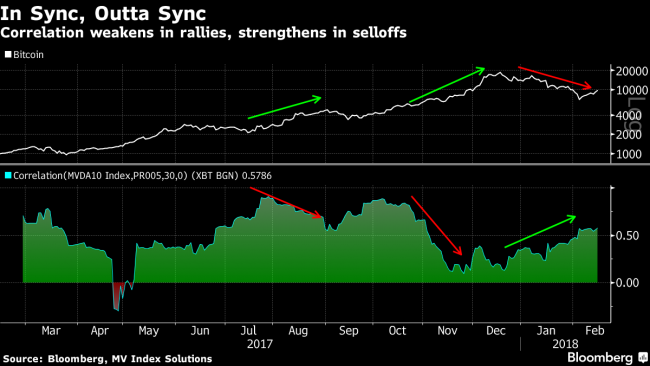(Bloomberg) -- Bitcoin’s leadership over other cryptocurrencies ebbs and flows -- an unnerving factor for traders trying to score with the next hot digital coin.
Investors saw this last year when Bitcoin’s 1,400 percent surge dominated headlines, yet smaller peers such as Ripple and Stellar far outperformed the world’s biggest cryptocurrency. When Bitcoin rallied, its tight correlation with rivals broke down, according to a Bloomberg analysis. On the contrary, when it tumbled, the so-called alternative coins dropped in step in a synchronous way, regardless of their individual merits.
“On the way up, people feel bold and will take more risk,” producing more varied movements in the class, said Arthur Hays, co-founder and chief executive officer of BitMex, a Seychelles-based trading platform. “But if Bitcoin falls sharply, it negatively affects sentiment across the whole crypto asset class. People sell everything.”
Digital assets move -- sometimes in spasms -- depending on sentiment, the tide of regulation and to some degree, correlation. Technical tools are increasingly offered to investors through start-up exchanges and are on the radar of the traditional securities firms that are gearing up coverage after the sector’s market value briefly exceeded $800 billion last month.
When Bitcoin tumbled for more than two weeks from its record high on Dec. 18, the correlation jumped from 0.19 to 0.57, according to an analysis of prices compiled by Bloomberg and MV Index Solutions, a Frankfurt-based data provider that began distributing the gauge Oct. 23.
In correlation analysis, the closer a reading is to 1.0, the more the two assets move together. Zero signals no correlation, and the closer to minus 1.0, the more inversely they move. The MV index includes Bitcoin, meaning the correlation coefficient is somewhat elevated.
Among the factors that can erode correlation is that many crypto investors hold their “cash” in Bitcoin. That means they have to switch out of it -- effectively a sale -- to snap up a smaller coin they think will climb faster when the whole market is gaining.
“In terms of correlations falling when it rallies, my hypothesis would be that people invest the capital gains in alt-coins looking for alpha, and each coin performs differently based on liquidity, narrative, sentiment and lots of idiosyncratic factors,” Lex Sokolin, global director of fintech strategy at Autonomous Research LLP, said in an email.
In general, investors seem more likely to run to Bitcoin at times of panic.
“I would expect to see a ‘flight to safety’ whereby ‘safety’ is denoted by size —- so, the largest coins are the benefactors of incoming capital flows during down markets," Spencer Bogart, partner at Blockchain Capital LLC, said in an email. “I would expect Bitcoin to be the most resilient in a broad crypto pull-back.”
